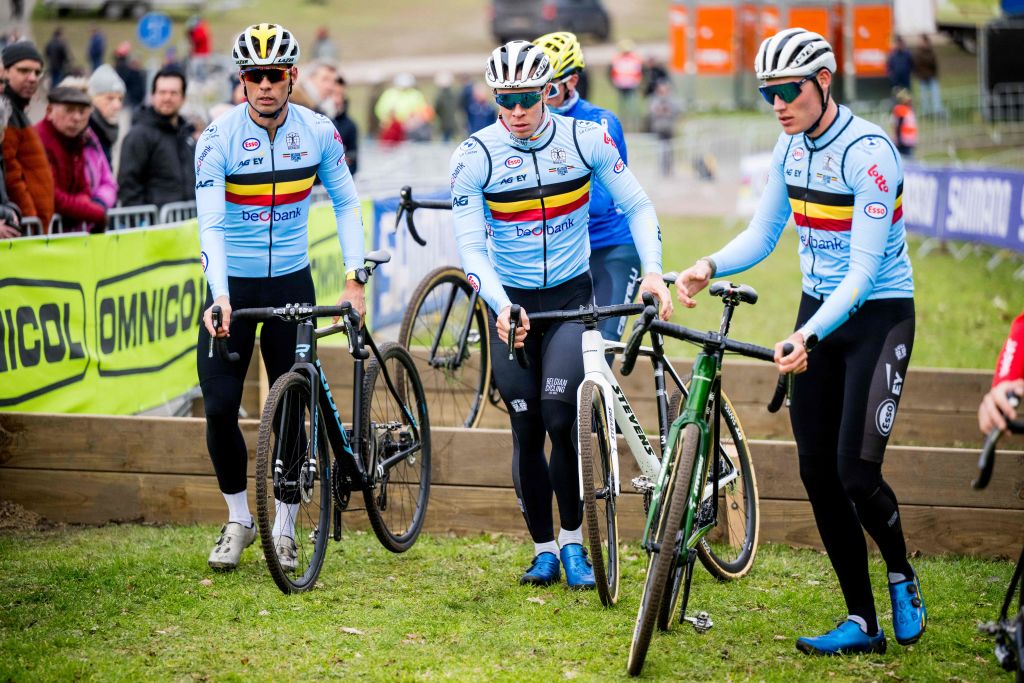Stairs are eye candy but barriers a bigger hurdle for Hoogerheide Cyclocross Worlds
'They are really in a very crucial place and are high' notes former World Champion Sven Nys

The course at the UCI Cyclocross World Championships in Hoogerheide, Netherlands was designed by Adrie van der Poel, who last raced competitively in 2000, finishing just off the podium in his final home Worlds in Sint-Michielsgestel. The 1996 elite men’s cyclocross world champion has a total of eight medals in all colours from the world championships, a number that his son, Mathieu van der Poel, surpassed last year with nine medals total (junior, U23 and elites), the last three gold.
The elder Van der Poel is still in the game himself, the designer for the course in Hoogerheide. He designed the last two Worlds courses that were held in the Netherlands - Hoogerheide in 2014 and Valkenberg in 2018, as well as the one in Bieles, Luxembourg in 2017. However, son Mathieu does not have an advantage, since he did not win on any of those other courses.
"I build a course with the resources I have and I don't look at riders. I look at the finish, tents, material stations [mechanics' pits] and parking lots, without thinking that a corner is in favor of Mathieu or anyone else," Adrie van der Poel said to Sporza.
He thought the layout was challenging, with a forecast of rain adding to the variables of the terrain. Many of the national teams practised on the track today under cloudy conditions and agreed with that assessment. Riders on the Dutch team noted the dry, fast sections were quite bumpy and could become treacherously slippery with more rain.
While the large stair structure looms as the eye candy of the course, the barriers could be the most decisive element, even at their relatively-diminutive size. Van der Poel said he originally did not plan to include the small planks in the design.
"I'm not in favor of barriers anyway and I didn't want them in the course until the chairman came up with an amount from the sponsor. Then I had to change course," he told Sporza, and said he moved them near the finish.
"Barriers have no function if you put them where you have to walk through the mud. It is still difficult to get to the finish afterwards. If you want to be sure at the barriers, you have to have 10 seconds. You will not win with a lead of two seconds."
Get The Leadout Newsletter
The latest race content, interviews, features, reviews and expert buying guides, direct to your inbox!
The barriers also caught the attention of Sven Nys, a four-time cyclocross world title holder with a total of nine elite medals. He told Het Nieuwsblad the exact specifications for height and course position "can really make the difference" if executed properly.
"They are really in a very crucial place and are high. Thin planks, high and uphill: so if you can take them with a little more guts, you are 10 meters ahead and then head for the finish via the stairs and a finish that is also slightly uphill, which you hardly ever see in the cross," he told Het Nieuwsblad. He explained that these man-made barriers were at the maximum height limit, 40 centemetres (16 inches), not the 35-centemetre height that is prevalent in other races like Superprestige or other series, which "are quite easy to do".
"Here they are as they used to be. If I had to go back, I would say 'hallelujah'," added Nys, who back in 2000 took the bronze medal at ‘cross Worlds in the Netherlands just ahead of the elder Van der Poel.
The uphill position comes into play for the rider who can carry the momentum in the pedals, too. Fatigue can play a part near the end of a race when the legs are heavy, but in any case the feature will provide entertainment for the spectators expected to pack the venue.
"Mathieu has the talent to jump over such barriers, Wout has learned it. And that can really make the difference in the speed of execution," Nys said. "Mathieu can maybe two km/h faster over the barriers than Wout, and that can be enough. As strange as it sounds, but it's all in the details. I therefore only expect the difference in the last rounds, it will be fantastic for the spectators."
If Mathieu van der Poel did not win the last three Worlds courses designed by his father, then who did? All three times Wout van Aert (Belgium) took the rainbow jersey, the first time as a 20-year-old in Hoogerheide in 2014. Mathieu van der Poel finished with a bronze in the 2014, a silver in 2017 and a bronze in 2018. Watch for Michael Vanthourenhout (Belgium), he was second-best in 2014 and 2018.

Jackie has been involved in professional sports for more than 30 years in news reporting, sports marketing and public relations. She founded Peloton Sports in 1998, a sports marketing and public relations agency, which managed projects for Tour de Georgia, Larry H. Miller Tour of Utah and USA Cycling. She also founded Bike Alpharetta Inc, a Georgia non-profit to promote safe cycling. She is proud to have worked in professional baseball for six years - from selling advertising to pulling the tarp for several minor league teams. She has climbed l'Alpe d'Huez three times (not fast). Her favorite road and gravel rides are around horse farms in north Georgia (USA) and around lavender fields in Provence (France), and some mtb rides in Park City, Utah (USA).